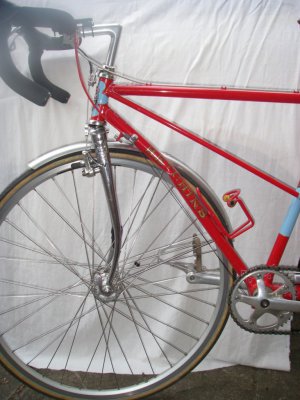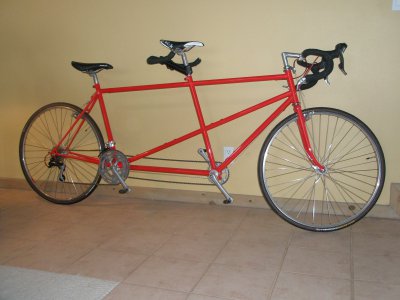Yikes, magbesium? That's pretty exotic, what's the joining method? Welding I assume, but what process, and what extra steps/precautions does mag require?
Dad's tandem looks amazing. Of course a modern frame now would have much larger diameter tubing, but I trust you found the rigidity adequate. My main concern is the 1" steerer — not even single bikes use such a small steerer anymore. I have broken two steerers (on singles) while riding, not fun. Do you know, did Columbus supply the same steerer they sold for single bike forks, or does this one have additional butting (thickening) at the bottom? The bottom is not only where forces are highest, it's also got weakening from the HAZ. If you're not sure, measuring the inside diameter at the bottom usually isn't too difficult, though Columbus complicates it slightly with their goofy raised helical ridges inside.
The helical ridges are an unfortunate feature, because they prevent you from strengthening the steerer by pressing in a doubler at the bottom. If you have a single-bike steerer and it has the ridges, then I'd recommend retiring the fork, replacing it with one with a real tandem steerer.
Back when tandems had 1" steerers, there were extra-thick butted steerers available from Reynolds, Ishiwata, maybe others. Santana took one of those and added a pressed-in doubler, so their steerers are reliable as far as I know. Never saw or heard of one broken. Adding a doubler is recommended for any 1" tandem steerer as long as it has a smooth bore inside.
"We rode it a lot and it didn't break" is not good enough — you know about fatigue, right? It's very difficult to inspect for incipient cracks there, so steerers usually snap with little to no warning. For this reason I strongly suggest steerers should be considerably stronger than the fork blades. If something's going to fail I'd prefer it to be the blades.
Here's an example of a tandem where they used a single-bike steerer with tandem blades:

BTW they were Just Riding Along (called "JRA" in the bike biz) when this happened. Claims of JRA are commonly made up to get warranty coverage after crashing into a parked car or driving it into the garage with the bike on the roof of the car, but in this case there were credible witnesses corroborating the story. He was applying the brakes when he hit a pot-hole.
See how the brake cable is out in front of the head tube? So the fork flexing back lengthens that path, which increases the application of the brake, which causes more fork flexing, which causes more increase in the braking, a runaway cascade. The brake lever snapped shut, nobody's hand can hold it against those forces, but by then the cascade was irreversible. It probably took a few milliseconds at most.
All single-bike tubing on this tandem, nothing "oversized", which I consider to be just short of criminal negligence. The maker, Bob Jackson, is out of business now, good riddance. The Hetchins on the downtube is just a resurrection of a long-defunct name with a storied history. Bob Jackson probably bought the IP, or the owner of the IP contracted BJ to make these.
-Mark



